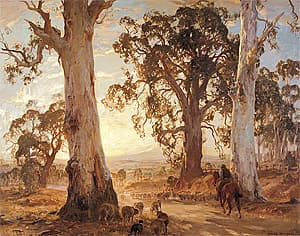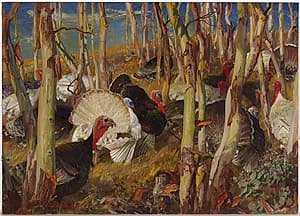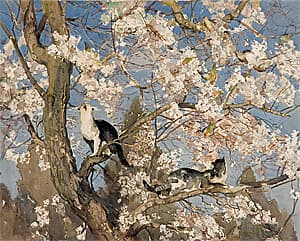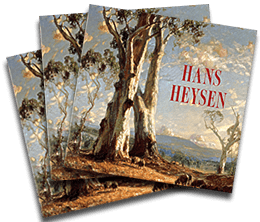About

Hans Heysen
A grand vision: strong forms and bold light
An Art Gallery of South Australia travelling exhibition
14 May – 11 July 2010 | Exhibition Galleries
One of Australia’s best-known landscape painters, Hans Heysen (1877–1968) was also one of the most successful during his lifetime. He changed the way we view the Australian landscape, with his distinctive gum trees having now become a part of our national imagery. The forthcoming exhibition at the National Gallery of Australia celebrates Heysen’s work.
Heysen painted the majesty of Australia. He did so through his images of huge gum trees around Hahndorf and the stark hills of the Flinders Ranges. Heysen’s largeness of vision is evident in oil paintings such as Mystic morn 1904, Red gold 1913 and Droving into the light 1914–21.
 Hans Heysen 'Droving into the light' 1914-1921 Art Gallery of Western Australia, Perth, gift of Mr W H Vincent, 1922
Hans Heysen 'Droving into the light' 1914-1921 Art Gallery of Western Australia, Perth, gift of Mr W H Vincent, 1922 In these works, Heysen observed nature acutely, portraying individual species of gum trees in all their specificity—a river red gum distinguished from a white gum or a stringybark. But these images are not just descriptive; they are triumphant portraits, with symbolic resonance. Heysen ‘humanised’ his trees into dramatic self-conscious poses, imbuing them with qualities of endurance, resilience and grandeur. And he arranged his trees within the landscape as if they were sculptural forms or architectural columns.
Mystic morn, for instance, depicts two young cows moving through a eucalyptus grove in the early morning light. Heysen painted it soon after his return to Adelaide after studying in Europe for four years, and it reflects his new awareness of the character of the Australian bush. In the exhibition at the National Gallery of Australia, visitors will be able to see together for the first time four versions of this image: two drawings, one watercolour and an oil painting.
They will be able to observe how the artist explored the same subject in different media. In the first drawing, Group of young trees c 1904, Heysen made a tentative sketch, possibly outdoors, depicting sinuous trees and their peeling bark. The second drawing, Study for ‘Mystic morn’ 1904, is a densely worked compositional study for the oil painting, with very faint grid lines dividing the image into 16 even rectangles in preparation for transferring the design onto canvas—a method Heysen used throughout his career. This compositional drawing also includes a man beside the cow on the left, showing that Heysen initially considered including a figure in the painting. These changes demonstrate the way that Heysen carefully composed his landscapes—after first having made a sketch directly from nature.
He worked on his composition to make it more balanced and harmonious, and sought to direct the viewer’s eye through the image. The watercolour, Study for ‘Mystic morn’ 1904, may have been painted before the finished oil, but it could possibly have been painted after it. Unlike the carefully worked drawing, it is a freer image, painted in rich strong colours and using the watercolour medium to capture an intense light. There are no cows in this image, and the trees are more interwoven and intertwined. The trees almost seem to come to life. The work is also related to another oil painting by Heysen, Sunshine and shadow 1904–05.
In 1926, in search of a change in his art, Heysen visited the Flinders Ranges, more than 500 kilometres north of Adelaide, and began to depict the ancient mountain ranges there.
Before this, he had been attracted to the theme of nature laid bare, to scenes of quarries and cliff faces, but from 1926 to 1933 the dry bare-boned terrain of the Flinders Ranges became the focus of his art. He admired the way in which the hills were defined by light. He captured the sharp profiles of the hills, the clarity of the light, and the intense colours. But, more significantly, he saw this landscape as being dateless, frozen in time, and he captured its haunting silence. Writing to Sydney Ure Smith, Heysen observed that in the Flinders Ranges the scene was ready-made, ‘fine big simple forms against clear transparent skies—and a sense of spaciousness everywhere’.
Heysen was also interested in capturing the Australian sunlight in all its variety—from a brilliant glare to a misty haze. And through this he conveyed a sense of the spiritual or sublime in nature. In Droving into the light 1914–21, for instance, Heysen expressed his love of light, glowing through the monumental gums at the end of the day. The massive foreground trees provide scale for the picture as well as a frame directing the attention of the viewer towards the centre of the composition. It is a vision of nature as homely, secure and peaceful; a promised land.
In addition to his evocative gum tree paintings and the magnificent barren landscapes of the Flinders Ranges, the exhibition includes a number of Heysen’s lesser-known images, from his early student days and his time in Europe from 1899 to 1903. There are portraits of Heysen’s wife Sallie and still-lifes depicting the vegetables from his garden. There are landscapes that reflect Heysen’s experience of bushfires in the Adelaide hills, in which he captured the fierce blaze of the fire and the stifling heat emanating from it. And there are images of sheep wandering on dusty roads during a drought, which conjure up the smell of the hot, dry air.
Among Heysen’s intimate and domestic images is the delightful watercolour of two cats in a tree, Spring 1925. It is a simple snatch of life—with the cats stretching, crouching, possibly waiting for coming prey, or maybe just basking in the sun. Likewise, Bronzewings and saplings 1921 is a sparkling image and one of Heysen’s major watercolours. Here, the artist depicted a group of albino turkeys within a sapling glade. The Hahndorf postmistress had given him a number of bronzewing turkey eggs and, to his surprise, when the eggs hatched many of the chicks turned out to be white. The combination of bronzewing and white turkeys inspired this work. He took much care in painting the scene, laying down each colour freshly with a crisp edge and arranging the composition like a mosaic.
 Hans Heysen 'Bronzewings and saplings' 1921
Art Gallery of South Australia, Adelaide, South Australian Government Grant 1937
Hans Heysen 'Bronzewings and saplings' 1921
Art Gallery of South Australia, Adelaide, South Australian Government Grant 1937
Heysen considered it one of his most complicated pieces of design. Some years after he had painted this watercolour, the Commonwealth Government commissioned Heysen to paint a similar work in oil, which he called The promenade 1953. In Canberra, both the watercolour and the oil will be shown together for the first time.
There is much to see in this exhibition, which throws a different light on Heysen. Ron Radford, Director of the National Gallery of Australia, has summed up the artist’s achievements:
Heysen made the Australian gum tree monumental and the hero of his nationalistic pictures. His paintings of the rocky, arid region of the Flinders Ranges from the late 1920s onward added a new dry and sculptural aesthetic, emphasising the reds and ambers of inland Australia.
Comprising about 80 works, the exhibition Hans Heysen at the National Gallery of Australia has been organised and curated by the Art Gallery of South Australia.
Anne Gray
Head of Australian Art
Exhibition book
This beautifully designed and lavishly illustrated exhibition book is a great addition to any art lover’s collection. Read more
$39.95 NGA shop price

